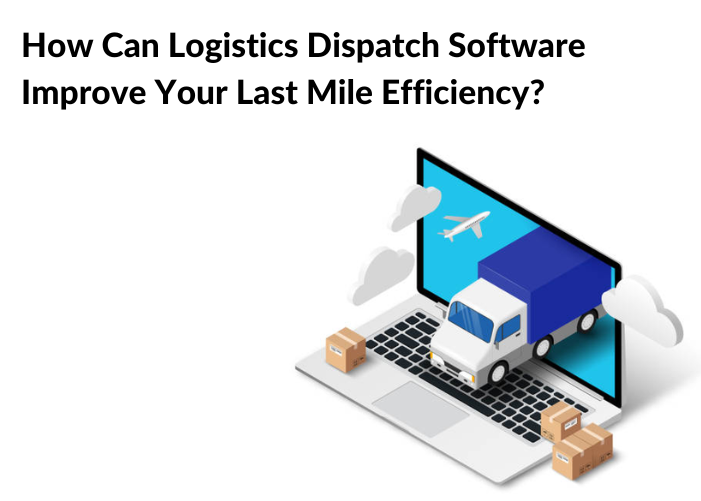Summary
In our globally competitive world, the industry of logistics and distribution has come under increased pressure to maintain delivery times and delivery costs that are demanded by today’s modern customers. This pressure becomes even more acute over the last mile of delivery.
The first, and most important, a step toward achieving such last-mile efficiency is to automate the process by implementing high-quality logistics-dispatch software.
What does last-mile efficiency mean?
Optimizing last-mile operations by making the best use of (available) limited resources to achieve best-in-class last-mile performance can be defined as last mile efficiency.
Fleet routing and utilization, minimizing the distance traveled, achieving a high percentage of on-time deliveries, and reducing fuel consumption are just some of the metrics that need to be optimized to achieve this efficiency. And, all this is geared toward the most important metric, i.e., achieving customer satisfaction.
Why is it important to focus on last-mile delivery efficiency?
Simply put, the last-mile efficiency of a company is the differentiating factor between providing its customers with a solid order fulfillment experience, or, faltering to do so and providing an unsatisfactory one.
Focusing on last-mile efficiency enables companies to:
- Reduce delivery times for its products
- Optimize fuel consumption, reduce emissions
- Manage last-mile complexities
- Minimize delayed and failed deliveries Achieve high levels of customer satisfaction
Top 5 ways to improve last-mile efficiency by using logistics dispatch software.
With rapidly evolving consumer preferences, an increasing number of businesses have started to enhance their last-mile efficiency in trying to keep their customers satisfied. Using automated logistics-dispatch software is the first step in this direction.
Let’s look at the top 5 ways to do so:
1. Customer’s preference for delivery-windows: An important requirement for customers today is that suppliers offer them the flexibility to choose delivery windows for their package deliveries. In fact, failure to do so will result in the risk of them shifting elsewhere.
To offer this service by manual calculations makes it prone to errors, resource-intensive, and extremely costly – so much so, that firms often don’t allow this option to their customers. Importantly, mismanagement of delivery slots results in delayed deliveries, thereby leaving the customer dissatisfied.
However, using logistics dispatch software would enable automating this function. The numerous variables that need balancing, including scheduling of deliveries, the type of fleet vehicles and drivers required, the time is taken for it (etc.), would be automatically built into this calculation.
This reduces delayed deliveries, failures, and rescheduled deliveries, thereby minimizing costs and errors.
2. Live-tracking of deliveries: Back in the day, the good ole “your order is out for delivery” was good enough – not for today’s customers though! They demand to be kept in the loop right from the time that their parcel leaves the warehouse till such time that it arrives at their doorstep, replete with live notifications, accurate ETAs, email and SMS notifications, and exact progress as it moves through its locations.
Therefore, unless companies use tools and systems to manage their last-mile delivery to provide such live tracking to their customers, their last-mile efficiency would fall short.
By using dispatch software, logistics firms are able to provide customers with the current status of their deliveries, reschedule them, communicate with delivery teams, and provide instant feedback on their delivery experiences.
Another important aspect of this is the reduced pressure – and, thereby costs – of having to maintain customer support teams.
3. Handle rescheduled deliveries efficiently: For consumers and order fulfillment companies in today’s world of eCommerce, failed deliveries as well as delayed deliveries are, unfortunately, a reality of this world. This occurrence will never ever go away completely. However, it can be reduced as best as possible by using modern tools and systems.
With logistics companies delivering a huge number of orders every day, the task of rescheduling order deliveries can cause major disruptions because it interferes with pre-planned schedules and routes.
Issues such as unavailability of drivers and fleet vehicles, increased last-mile costs, burdening available resources, and risking vehicle breakdown are just some of the pitfalls here. Dispatch software can reschedule orders, set optional delivery locations, and manage high volumes of orders with almost no human resources involved.
Using its inbuilt optimization tools, it balances out numerous variables—including driver availability, workload balancing, and capacity planning—to come up with the most optimized delivery windows.
4. Order-returns: By extension of the point above, order returns are also a reality in today’s Ecommerce world. The trick is to maintain an effective and easy way to do so – this ensures a positive customer experience and maintains customer satisfaction.
Dispatch software has intelligent scheduling features that enable logistics managers to handle huge volumes of orders by clustering return pickups and rescheduled deliveries within one swing. This minimizes costs, and saves resources, money, and time, thus reducing the total (reverse) operating costs for companies. It is important to remember also, that improving last-mile efficiency would naturally mean that the number of order returns would be minimized in the first place.
5. Delivery options and speeds: An important change in today’s customers versus that of earlier generations are their demands around order delivery speeds and options offered. Weaned on a diet of Same-day delivery and 24-hr delivery, this has now become the new normal.
This poses a constant problem for companies as they grapple with quick delivery times at manageable delivery costs. Additional constraints like customer delivery windows, re-scheduling, traffic, and weather (etc.) make the task even more difficult.
Dispatch software comes up with the shortest possible delivery times and options by balancing all the operational constraints. Its inbuilt Artificial Intelligence and Machine Learning tools are able to crunch vast amounts of data and arrive at the optimal routes. Zone-wise routing, clearly demarcated delivery zones, order-clustering (etc.) are some examples of methods that dispatch software deploys.
Conclusion: In our globally competitive world, as eco-systems and last-mile logistics turn more complex every day, the challenge for Logistics and Distribution firms to maintain efficient and profitable operations is a real one.
Within this, the complexities of improving last-mile efficiencies take the challenge to an entirely different level altogether. Using best-in-class last mile delivery software is the first, and arguably the most important, step in this direction. Without it, logistic and distribution firms cannot hope to achieve acceptable levels of last-mile efficiency and will gradually lose customers to competitors.




